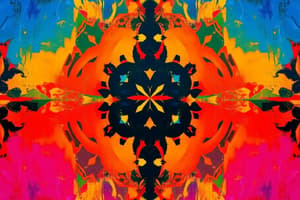Podcast
Questions and Answers
Define balance. Explain the difference between formal balance and structural balance.
Define balance. Explain the difference between formal balance and structural balance.
Balance is the arrangement of elements within a piece so that no part overpowers another. Formal balance occurs when a piece has linear symmetry, meaning if it was divided in half, one side would mirror the other. Structural balance includes symmetry but also ensures a piece is both stable and aesthetically pleasing.
Has the artist in the piece entitled 'Canyon' used all seven principles of design? Give one example of balance, harmony, proportion, and movement used by the artist.
Has the artist in the piece entitled 'Canyon' used all seven principles of design? Give one example of balance, harmony, proportion, and movement used by the artist.
Yes, the artist has used balance created by a vertical line of symmetry, harmony through similar hues, proportion by the relative size of elements, and movement with the vertical lines of the squares that lead down to the eagle.
Explain the difference between symmetry and asymmetry.
Explain the difference between symmetry and asymmetry.
Symmetry is the visual quality of repeating parts of an image across an axis, while asymmetry refers to anything that isn't symmetrical.
List the principles of design.
List the principles of design.
When you look at this image, how would you describe it? Where does your eye want to go when you look at this piece?
When you look at this image, how would you describe it? Where does your eye want to go when you look at this piece?
Define symbolic proportion. How has the artist used symbolic proportion in 'Mary and Christ Enthroned'?
Define symbolic proportion. How has the artist used symbolic proportion in 'Mary and Christ Enthroned'?
Define movement as a principle of design in art. How did the artist, Duchamp, use movement in 'Nude Descending a Staircase'?
Define movement as a principle of design in art. How did the artist, Duchamp, use movement in 'Nude Descending a Staircase'?
Explain the following terms: proportion, emphasis, form.
Explain the following terms: proportion, emphasis, form.
Does this work of art have harmony and variety? Why?
Does this work of art have harmony and variety? Why?
Name the above painting and its artist. How has the artist used balance, variety, and movement to emphasize the man waving the cloth?
Name the above painting and its artist. How has the artist used balance, variety, and movement to emphasize the man waving the cloth?
Flashcards are hidden until you start studying
Study Notes
Balance in Art
- Balance refers to the arrangement of elements so that no part overpowers another.
- Formal balance features linear symmetry, mirroring one side to the other.
- Structural balance emphasizes both stability and visual appeal in architectural designs.
Principles of Design in "Canyon"
- The art piece "Canyon" employs all seven principles of design: balance, harmony, variety, proportion, movement, emphasis.
- Balance is achieved with a vertical line of symmetry and color flow.
- Harmony is created using similar hues and shapes.
- Proportion consists of the sizes of different elements being visually correct.
- Movement guides the eye from the top of the painting down to the main subject, the eagle.
Symmetry vs. Asymmetry
- Symmetry is characterized by repeating parts across an axis or center.
- Asymmetry describes elements that are not symmetrical.
Comprehensive List of Design Principles
- Key principles: Contrast, Balance, Emphasis, Movement, White Space, Proportion, Hierarchy, Repetition, Rhythm, Pattern, Unity, Variety.
Observation of Art Elements
- In the analyzed piece, words contrast the black-and-white image, enhancing visibility.
- Placement of words adds depth and influences viewer's focus.
Symbolic Proportion
- Symbolic proportion refers to the disproportionate relationship between objects conveying significance.
- It exemplifies importance through visual techniques.
Movement in Design
- Movement provides a sense of motion within the artwork.
- Duchamp's "Nude Descending a Staircase" conveys movement through repeated forms and diagonal lines.
Key Artistic Terms
- Proportion: Relationship between parts and their overall impact.
- Emphasis: Creation of focal points for viewer attention.
- Form: Any three-dimensional geometric shape or visible element in artwork.
Harmony and Variety in Art
- Harmony creates visual appeal through compatible colors and repetitive elements.
- Variety introduces differences in sizes and shades for visual interest.
Analysis of "The Raft of the Medusa"
- Painted by Theodore Gericault in 1819, the artwork emphasizes the man waving a cloth.
- The figure is highlighted through a contrast of skin tones and a triangular arrangement of supporting characters.
- Movement is depicted in the fluttering cloth, contributing to the dynamic feel of the painting.
Studying That Suits You
Use AI to generate personalized quizzes and flashcards to suit your learning preferences.



